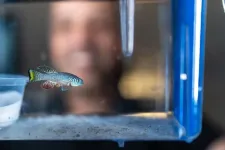(Press-News.org) PULLMAN, Wash. – A parasitic worm that can infest the brains of moose appears to be playing a role in the decline of the iconic animal in some regions of North America.
Moose populations have been dwindling for years across the country due to many contributing factors, but new research at Washington State University has found the impact of Eleaophora schneideri, also known as the arterial worm, has likely been underestimated.
Researchers examined recently deceased Shiras moose in Idaho between March 2020 and July 2022. While the parasitic roundworm E. schneideri was not detected in any of the animals found in north Idaho, it was present in 10 of the 20 adult moose studied in the southeastern portion of the state. Nine of the infected not only had adult worms in their major arteries but their brains were littered with microfilariae, the microscopic early life stage of the worm.
“The microfilaria are just scattered throughout their brains, and even though the damage from each is miniscule, they're basically shot-gunning the whole brain,” said Kyle Taylor, a pathologist at WSU’s Washington Animal Disease Diagnostics Laboratory. “We hypothesize the cumulative effects of large numbers of microfilariae in the brain may be associated with increased morbidity or chance of mortality, with mortality more likely in cases with larger numbers of worms.”
The research, published in the Journal of Wildlife Diseases, is part of a three-year collaborative project on moose mortality with the Idaho Fish and Game and Dr. Janet Rachlow of the University of Idaho, College of Natural Resources.
E. schneideri is primarily transmitted by tabanid flies like horse and deer flies. Mature worms can measure as long as 4.5 inches and are most commonly found in the carotid arteries in the area of the head and neck, where they will mate and release microfilariae into the bloodstream.
Infection can lead to a condition known as elaeophorosis in which the host’s circulation system is disrupted. It can advance to blindness, abnormal behavior, damage to the ears and muzzle, and death. Infections have been reported in a variety of species, including deer, domestic and wild sheep, and elk. Unlike moose, mule deer and black-tail deer are considered to be natural hosts and typically show minimal to no signs of infection.
There are currently no tests available to determine whether a live moose is infected with the parasite.
Taylor’s team examined 61 recently deceased moose in Idaho. No evidence of infection was found in northern Idaho moose or juveniles, but 10, or half, of the adult moose studied in southeastern Idaho were infected. Of those 10, three had damage to the tips of their ears, a condition attributed to E. schneideri infection. Four exhibited abnormal behavior prior to their deaths, possibly due to neuropathology associated with the parasite.
Based on their findings and that of other research, Taylor suspects the subtle but widespread damage to the brain caused by the worms may be leading to reduced fitness of the moose, which could increase risk of predation, and, sometimes, cause death.
“We really need to have an understanding of all the issues related to moose population decline, and this parasite appears to be a factor,” Taylor said.
The study also explored the geographic spread of E. schneideri in Idaho. The parasite was found to be widespread in southeastern Idaho, aligning with its prevalence in neighboring regions of Montana and Wyoming. The distribution coincides with populations of mule deer.
Christine Haake, a pathology resident at WADDL and graduate student in the Department of Veterinary Microbiology and Pathology, helped to lead the study. Field sampling was performed and directed by Dr. Logan Weyand, who was a graduate student at the University of Idaho during the project. WADDL pathologist Chrissy Eckstrand and parasitologist Laura Williams assisted with the research.
END
Parasitic worm likely playing role in decline of moose populations
2024-05-15
ELSE PRESS RELEASES FROM THIS DATE:
Transcatheter valve replacement outcomes similar to surgery
2024-05-15
A new study demonstrated parity between a minimally invasive procedure to replace the aortic valve in the heart—transcatheter aortic valve replacement (TAVR)—and surgical aortic valve replacement (SAVR).
In the meta-analysis of seven randomized trials, published in JSCAI and presented at the 2024 EuroPCR conference in Paris, France, researchers compared the outcomes of 7,785 patients undergoing TAVR (a procedure that delivers a new aortic valve into the heart through a catheter) to those undergoing SAVR for severe aortic stenosis. ...
Germline regulation and sex differences: How they impact lifespan in vertebrates
2024-05-15
The study revealed unexpected and sex-specific effects of germline regulation on longevity and somatic repair in vertebrates. Contrary to classical evolutionary theories, it turns out that changing how the germline (the part responsible for reproduction) works can have different effects on males and females. This challenges conventional beliefs that reproduction and longevity are linked by a limited pool of resources. The research opens up new possibilities for understanding how our bodies age and the role of reproduction in that process. The findings ...
Detection of an Earth-sized exoplanet orbiting the ultracool dwarf star SPECULOOS-3
2024-05-15
The SPECULOOS project, led by the astronomer Michaël Gillon from the University of Liège, has just discovered a new Earth-sized exoplanet around SPECULOOS-3, an "ultracool dwarf" star as small as Jupiter, twice as cold as our Sun, and located 55 light-years from Earth. After the famous TRAPPIST-1, SPECULOOS 3 is the second planetary system discovered around this type of star.
Ultra-cool dwarf stars are the least massive stars in our Universe, similar in size to Jupiter, more than twice as cold, ten times less massive and a hundred times less ...
Scientists discover blood proteins that may give cancer warning 7 years before diagnosis
2024-05-15
Two Cancer Research UK-funded studies from Oxford Population Health have discovered proteins in the blood that could warn people of cancer more than seven years before it is diagnosed.
Scientists identified 618 proteins linked to 19 different types of cancer, including 107 proteins in a group of people who blood was collected at least seven years before diagnosis.
The team have discovered that these proteins could be involved at the very earliest stages of cancer, where it could be prevented.
They ...
Astronomers discover new Earth-sized world orbiting an ultra-cool star
2024-05-15
A new, Earth-sized planet orbiting an ultra-cool red dwarf star, has been detected by an international team of astronomers – just 55 light years away.
The planet is only the second of its kind to be discovered around this type of star. Called SPECULOOS-3 b, it takes around 17 hours to complete an orbit of the star which is more than twice as cold as our sun, as well as ten times less massive and a hundred times less luminous.
Days and nights on SPECULOOS-3 b seem to be endless: the planet is likely to be tidally locked, so the same side – the ‘dayside’ – always faces the star in a relationship similar to our moon and Earth.
The ...
New biomarker to diagnose Alzheimer's in asymptomatic stages
2024-05-15
A recent study led by the Molecular and Cellular Neurobiotechnology group at the Institute for Bioengineering of Catalonia (IBEC) and the University of Barcelona has identified a new biomarker for Alzheimer's disease in asymptomatic stages of the disease. The molecule is miR-519a-3p, a microRNA directly linked to the expression of the cellular prion protein (PrPC), which is deregulated in people suffering from some neurodegenerative diseases such as Alzheimer's.
The search for biomarkers that are stable and easily detectable in biofluids, ...
Research sheds light on how proteins linked to Alzheimer’s disease influence neuronal growth
2024-05-15
New research has shed light in the complex interplay between cell proteins, and how they impact on neurons in neurodevelopmental disorders and Alzheimer’s disease.
A new study led by the University of Exeter and published in Royal Society Open Biology has discovered the key role that the protein Contactin-4 (encoded by the gene CNTN4) plays in shaping neurons.
The researchers began studying CNTN4 because it was known to have a role in autism, but its functional roles were not well understood. The team explored how CNTN4 functions within the brain, particularly its interactions with proteins involved in neurodegenerative diseases like Alzheimer's ...
Early retirement of old vehicles won't save the planet: A study
2024-05-15
Lifespan caps for passenger vehicles have limited effect on reducing greenhouse gas emissions and could drive up costs and material use finds a new study published in Environmental Research: Infrastructure and Sustainability. The research shows that although Light-Duty vehicles (LDVs) contribute 17% to the annual greenhouse gas emissions in the United States, imposing a 15-year lifespan cap on LDV fleets under a business-as-usual scenario will not lead to any meaningful reductions in GHG emissions.
To combat delayed uptake of Electric Vehicles (EVs), some have argued for limits on the vehicle’s ...
EuroPCR 2024 – Short-term data from NOTION-2: TAVR versus SAVI for younger patients with aortic stenosis
2024-05-15
Paris, France, 14-17 May 2024. The Course Directors have selected 3 major Late Breaking Trials (LBTs) that will be presented for the first time during the 2024 edition of EuroPCR. These trials were selected on account of their design, outcomes and potential to influence daily clinical practice. Among them is the NOTION-2 randomised clinical trial (RCT).
Background
Evidence comparing the use of transcatheter aortic valve implantation (TAVI) and surgical aortic valve replacement (SAVR) in low-risk patients with aortic ...
EuroPCR 2024 – One-month DAPT followed by 5-month Ticagrelor monotherapy in acute coronary syndromes with DCB - results from REC-CAGEFREE II
2024-05-15
Paris, France, 14-17 May 2024. The Course Directors have selected 3 major Late Breaking Trials (LBTs) that will be presented for the first time during the 2024 edition of EuroPCR. These trials were selected on account of their design, outcomes and potential to influence daily clinical practice. Among them is the REC-CAGEFREE II trial.
Background and methods
The REC-CAGEFREE II trial is an open-label, investigator-initiated, non-inferiority, multicentre randomised trial comparing stepwise de-escalation of dual antiplatelet therapy (DAPT) with standard DAPT in patients with acute coronary syndrome (ACS) treated with paclitaxel-coated balloons (PCB). Eligible ...



